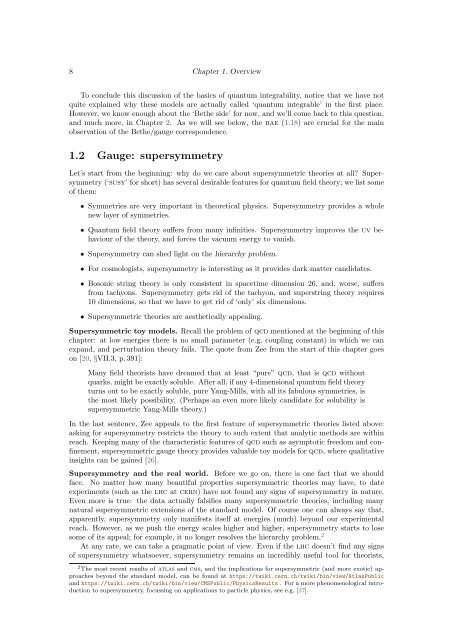The Bethe/Gauge Correspondence
The Bethe/Gauge Correspondence
The Bethe/Gauge Correspondence
Create successful ePaper yourself
Turn your PDF publications into a flip-book with our unique Google optimized e-Paper software.
8 Chapter 1. OverviewTo conclude this discussion of the basics of quantum integrability, notice that we have notquite explained why these models are actually called ‘quantum integrable’ in the first place.However, we know enough about the ‘<strong>Bethe</strong> side’ for now, and we’ll come back to this question,and much more, in Chapter 2. As we will see below, the bae (1.18) are crucial for the mainobservation of the <strong>Bethe</strong>/gauge correspondence.1.2 <strong>Gauge</strong>: supersymmetryLet’s start from the beginning: why do we care about supersymmetric theories at all? Supersymmetry(‘susy’ for short) has several desirable features for quantum field theory; we list someof them:• Symmetries are very important in theoretical physics. Supersymmetry provides a wholenew layer of symmetries.• Quantum field theory suffers from many infinities. Supersymmetry improves the uv behaviourof the theory, and forces the vacuum energy to vanish.• Supersymmetry can shed light on the hierarchy problem.• For cosmologists, supersymmetry is interesting as it provides dark matter candidates.• Bosonic string theory is only consistent in spacetime dimension 26, and, worse, suffersfrom tachyons. Supersymmetry gets rid of the tachyon, and superstring theory requires10 dimensions, so that we have to get rid of ‘only’ six dimensions.• Supersymmetric theories are aesthetically appealing.Supersymmetric toy models. Recall the problem of qcd mentioned at the beginning of thischapter: at low energies there is no small parameter (e.g. coupling constant) in which we canexpand, and perturbation theory fails. <strong>The</strong> quote from Zee from the start of this chapter goeson [20, §VII.3, p. 391]:Many field theorists have dreamed that at least “pure” qcd, that is qcd withoutquarks, might be exactly soluble. After all, if any 4-dimensional quantum field theoryturns out to be exactly soluble, pure Yang-Mills, with all its fabulous symmetries, isthe most likely possibility. (Perhaps an even more likely candidate for solubility issupersymmetric Yang-Mills theory.)In the last sentence, Zee appeals to the first feature of supersymmetric theories listed above:asking for supersymmetry restricts the theory to such extent that analytic methods are withinreach. Keeping many of the characteristic features of qcd such as asymptotic freedom and confinement,supersymmetric gauge theory provides valuable toy models for qcd, where qualitativeinsights can be gained [26].Supersymmetry and the real world. Before we go on, there is one fact that we shouldface. No matter how many beautiful properties supersymmetric theories may have, to dateexperiments (such as the lhc at cern) have not found any signs of supersymmetry in nature.Even more is true: the data actually falsifies many supersymmetric theories, including manynatural supersymmetric extensions of the standard model. Of course one can always say that,apparently, supersymmetry only manifests itself at energies (much) beyond our experimentalreach. However, as we push the energy scales higher and higher, supersymmetry starts to losesome of its appeal; for example, it no longer resolves the hierarchy problem. 2At any rate, we can take a pragmatic point of view. Even if the lhc doesn’t find any signsof supersymmetry whatsoever, supersymmetry remains an incredibly useful tool for theorists,2 <strong>The</strong> most recent results of atlas and cms, and the implications for supersymmetric (and more exotic) approachesbeyond the standard model, can be found at https://twiki.cern.ch/twiki/bin/view/AtlasPublicand https://twiki.cern.ch/twiki/bin/view/CMSPublic/PhysicsResults . For a more phenomenological introductionto supersymmetry, focussing on applications to particle physics, see e.g. [27].
















